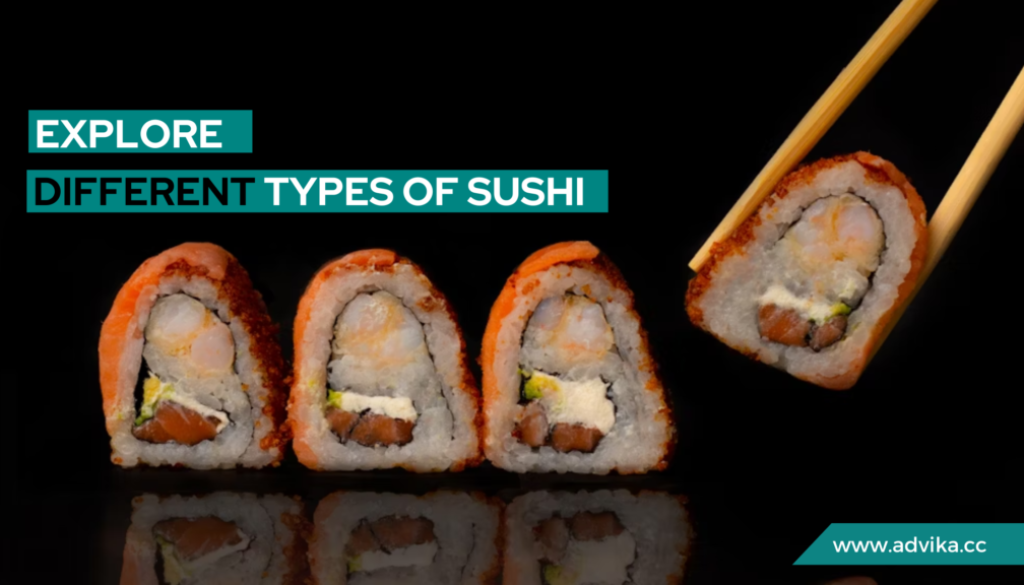Types of Sushi
Sushi is a popular Japanese dish adored by many people around the world globally. Different types of Sushi are well known for their exquisite appearance and subtle taste, and it is a dish that takes culinary talent to accomplish.
From a simple and traditional nigiri to colourful and beautiful chirashizushi, sushi offers terrific flavours and cultural significance. Whether you are a sushi lover or a person interested in food, this blog will help you gain a better understanding of sushi and its role in world food culture.
What Is Sushi?
Sushi – Rice, prepared and seasoned with vinegar, served with fish, seafood, vegetables, or sometimes even fruits like mangoes or any other tropical fruits like mango. Despite the initial impression that sushi is referred to as fish, the word “sushi” actually refers to vinegared rice (shari or sushi), and they can be served hand-pressed or into rolls.
What Is Sushi Vinegar?
Sushi vinegar (sushi) is one of the main ingredients used in preparing sushi, and it gives the rice a very distinct taste. Its preparation often involves the combination of rice vinegar, sugar and salt, which needs to be boiled and then cooled down before use. There may also be a bit of sake or mirin in some recipes. Then, seasoned vinegar was added to the cooked rice to provide the desired taste, which is a combination of sweet and salty with a hint of sour.
Here are the ten interesting types of Sushi:-
1. Nigiri

Nigiri is one of the oldest types of sushi that are initially prepared and traditionally served. It is a small ball of vinegared rice garnished with raw or cooked fish, seafood or significantly finely chopped fish or seafood. Sometimes, a little dab of wasabi is inserted between the rice and the top layer of fish. If the dish is going to be garnished, then the topping is served with a thin strip of nori (seaweed) laid across the dish to hold the topping in position.
Nigiri sushi is very simple and focuses more on the essence and taste of the fish it comes with; therefore, it is considered by those who love sushi most. These include tuna (maguro), salmon (sake), shrimp (ebi) and eel (unagi) among others. The toppings range from tuna to salmon to shrimp and eel, among others.
2. Makizushi (Maki Sushi)
Makizushi, or “rolled sushi”, refers to a technique in which a sheet of nori is used to encase vinegared rice and other fillings. The roll is then cut into small portions by slicing them. There are several types of makizushi:
Futomaki

Futomaki is large in size and thickness, and they contain many types of fillings, like cucumber tamago (a Japanese omelette). Another popular filling is kanpyō, which is made of dried gourd strips. This sushi is primarily vegan, but it may contain seafood or meat as well.
What makes futomaki appealing to the eye is that they come in a wide range of colours, and this makes them very attractive. These rolls are enjoyed during festive occasions in Japan.
Hosomaki

Hosomaki is a type of sushi that is rolled thinly and usually has only one or two ingredients. These smaller rolls highlight the tastes of the main components like tuna (tekka maki), cucumber (kappa maki), and pickled daikon radish (oshinko maki).
Since hosomaki has such simplistic roll compositions, the unique taste of each ingredient used in the sushi roll can shine. These can be usually seen when preparing and serving sushi on a platter along with various other sushi.
Temakizushi (Temaki Sushi)

Temakizushi, or ‘hand-rolled sushi’, is shaped in the form of a cone and eaten with hands. The nori is then folded around the vinegared rice and some fillings like fish, meat, vegetables, and avocado to give visually appealing and mouth-watering sushi.
Temaki is very fun-filled, and it is likely eaten at sushi parties, making it more popular than other sushi.
Uramaki

Uramaki, or “inside-out rolls”, have rice outside and also seaweed on the inside; one of the famous uramaki is the California roll, which has imitation crab or real crab, avocado and cucumber in most cases. Some of the toppings that are usually placed on uramaki include sesame seeds or tobiko, which are fish eggs.
Uramaki is made in a way that caters to Western tastes; hence, varieties of imaginative and delicious ingredients are used in the making of the roll.
3. Chirashizushi

Chirashizushi, or “Scattered sushi”, is a type of sushi made with vinegared rice in a bowl or on a plate on top of which raw shredded fish, tempura, boiled eggs, and many other things are placed. This style is implied to be consumed during special occasions such as Christmas, for instance.
Chirashizushi can be very appealing in colour, with the toppings arranged artistically over the sushi rice. It is versatile and can be customized with seasonal ingredients.
4. Inarizushi

Inarizushi is made from vinegared rice stuffed into a pouch of seasoned aburaage (fried tofu) sweet and savoury pouches. Its portability makes it a favourite type of sushi that is taken when having picnics or as a snack.
Inarizushi has that sweet and sour taste that is most likely to be preferred by people who would prefer subtle tastes. In relation to the vinegared rice, the tofu sacs have an enjoyable difference in texture.
5. Temarizushi

Temarizushi, or “ball sushi,” is another unique type of sushi that is visually appealing and perfect for casual dining. It is made of small balls of vinegared rice with added toppings of fish slices, shrimp, or chopped vegetables. They are widely used in parties and other celebrations due to their decorative nature.
For those who have never tried sushi or do not like large portions and complicated shapes, Temarizushi can become the best variant because it is cute and delicious.
6. Gunkan Maki

Gunkan maki, or “battleship sushi,” is one type of sushi that is shaped like a small oval of rice covered with a strip of nori to look like a battleship in overall shape. This cup is then filled with different ingredients, and this may include ikura, which is a fish egg, uni, which is a sea urchin, or even chopped fish.
Since gunkan maki is more stable for holding toppings, the ingredients used in gunkan maki can be delicate and less structural, which allows the eater to experience the unique texture and taste of gunkan maki.
7. Narezushi

Narezushi is one of the traditional forms of sushi that originated primarily to preserve fish. The fish undergo fermentation with rice and salt for many months up to some years, resulting in rich flavour. Among them, Funazushi, which is a type of narezushi made from crucian carp, is now famous within culinary circles for its unique taste and cultural significance.
Narezushi also provides insight into the evolution of sushi and its roots as a method of fish preservation before the practice of sushi refrigeration. Its spiny mouth feels and feisty smell speaks volumes for it.
8. Oshizushi

Oshizushi, or “pressed sushi”, is made by placing vinegared rice on a wooden box along with toppings pressed into a rectangular shape. The sushi is then cut into smaller portions. This method provides a beautiful and neat look, showcasing the layering of fish, vegetables and rice.
Oshizushi is often served on formal occasions, and it also has elaborate presentations and accurate shapes to cater to high-end sushi restaurants.
9. Sasazushi

Sasazushi is a type of sushi localized in Niigata and Nagano prefectures. It is made by placing the vinegared rice along with the fillings, such as bamboo shoots, mushrooms, fish, etc, in the Bamboo leaves. The bamboo leaves are used to give the sushi a specific flavour and taste.
Sasazushi is very much tied to local products and the local ways of preparing sushi that are specific to Japan, showcasing its diverse sushi culture.
10. Kakinoha-zushi

Kakinoha-sushi is a regional speciality that comes from the Nara prefecture of Japan. However, the most common type is one that is made up of vinegared rice topped with slices of fish, such as mackerel or salmon, covered with persimmon leaves. The leaves of the persimmon give the sushi an aroma, while the leaves scientifically aid in the preservation of fish that is used in the sushi.
Kakinoha-sushi is preferably consumed during festivals and special occasions. The persimmon leaves are not actually eaten; they are just used for wrapping vegetables, and they also aid in preparing the sushi and making it tastier and presentable.
If you’re eager to explore the other types of sushi further or seek expert guidance on culinary matters, consider reaching out to food consultants in Bangalore. With their expertise and passion for gastronomy, they can offer invaluable insights and assistance in elevating your dining experiences to new heights.



